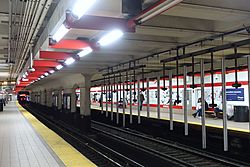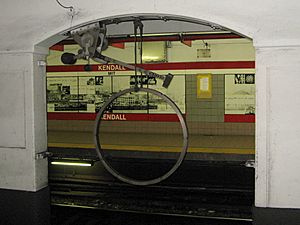Kendall Band facts for kids
Quick facts for kids Kendall Band |
|
|---|---|

Pythagoras is the largest component of the Kendall Band
|
|
| Artist | Paul Matisse |
| Year | 1986–1988 |
| Type | Interactive sound sculpture (aluminum, steel, teak) |
| Location | Kendall/MIT station, Cambridge, Massachusetts |
| Owner | MBTA |
The Kendall Band is a special musical sculpture made of three parts. It was created between 1986 and 1988 by Paul Matisse. He is the grandson of the famous French artist Henri Matisse. This amazing artwork is found at the Massachusetts Bay Transportation Authority's Kendall Station in Cambridge, Massachusetts. It's right near the MIT campus. Many people see it every day as they ride the subway.
The three parts of this interactive artwork are called Pythagoras, Kepler, and Galileo. You can play them using levers or handles on the subway platforms.
Contents
About the Kendall Band Sculpture
The Kendall Band is an interactive sound sculpture. This means you can play it! It's located in Cambridge, Massachusetts, at Kendall Station. The artwork has three musical instruments. You play them by using handles on the subway platform walls. Each instrument can be played from either side of the station. The artists used aluminum, steel, and teak wood to build these instruments. The teak was used for the hammer heads.
Paul Matisse created this unique artwork. He won a competition in 1981 to design something for Kendall Station. This was part of a project called "Arts on the Line". This program aimed to add art to the Red Line subway stations. It was the first program in the country to put art in public transportation. The sculpture was installed in 1987 after the station was rebuilt.
Matisse decided to place the sculpture between the subway tracks. He did this because he was worried about vandalism. He thought it would be safer there. Paul Matisse is also known for other interactive sound sculptures. One example is his Musical Fence (1980). It is now at the DeCordova Museum and Sculpture Park.
Pythagoras: The Bell Chimes
The Pythagoras part of the Kendall Band is named after Pythagoras of Samos. He was a famous Greek mathematician and scientist. This sculpture has 16 aluminum tubular bells. They are all tuned to the key of B minor. Longer bells make lower sounds, and shorter bells make higher sounds.
When you pull a handle on the subway platform, hammers swing and hit the bells. This creates musical notes. The bells have special cuts that make each note play with a slight vibrato. This makes the sound shimmer a little.
There are actually two Pythagoras instruments. One works from the inbound platform, and the other from the outbound platform. They can be played at the same time. The handles are not directly connected to the hammers. This stops people from hitting the chimes too hard. You need to move the handles back and forth in a steady rhythm. This builds up energy through mechanical resonance to make the hammers strike. Most visitors quickly learn how to play it without instructions.
Kepler: The Ring Gong
The Kepler section is named after Johannes Kepler. He was a German astronomer and mathematician from the 1600s. This instrument has a heavy metal ring. It weighs about 125 pounds. When it is struck, it plays an F♯ note. This note sounds good with the Pythagoras chimes.
You play this instrument by moving a handle on either subway platform. This makes a hammer move up. Then it falls and strikes the ring. After the ring is hit, it will hum for about five minutes.
Galileo: The Thunder Sheet
The Galileo instrument is a very large metal sheet. It is named after Galileo Galilei. He was an Italian physicist and astronomer. This flat steel panel works like a thunder sheet.
When you move a handle on the station platform, the sheet shakes. This creates a low rumbling sound. It sounds like thunder or like trains rolling through the station.
Keeping the Sculpture Working
Paul Matisse was the only artist in the "Arts on the Line" program to create art with moving parts. Soon after the Kendall Band was installed, it started to break. The Pythagoras instrument stopped working even before the others were fully installed. Matisse later said it was probably a bit "folly" to make something with moving parts.
Matisse's contract said the MBTA would pay for repairs. However, they did not pay him. So, he did the repairs for free. Over time, the sculpture was improved to make it stronger. One important change was adding special mechanical clutches. These clutches are hidden behind the handles. They stop the instruments from breaking if someone pulls too hard or too fast.
Matisse had to repair the sculpture himself whenever it broke. He could not find any group or company willing to take over the upkeep. Because of this, Matisse eventually stopped maintaining the artwork after about 20 years. He said it was like letting his kids grow up and go out on their own.
When the Sculpture Fell Apart
In 2007, the MBTA paid $10,000 for a one-time fix. But they said they could not pay for future repairs. All other repairs had to be paid for by Matisse himself. When Paul Matisse, then 74, stopped fixing the Kendall Band, it quickly broke down. Out of the original six handles, four were removed. Only the Galileo instrument was still working.
The original engineering drawings for the Kendall Band were also lost. This happened because of a hard drive crash. So, people had to figure out how it worked by taking it apart and measuring its pieces.
The Kendall Band Preservation Society
The Massachusetts Institute of Technology (MIT) is located near Kendall Square. In 2010, a group of MIT students came together to repair the Kendall Band. The idea came from Seth G. Parker, an energy consultant. He contacted Clarise E. Snyder at MIT's Concerts Office. She then reached out to Paul Matisse and the MIT Department of Materials Science and Engineering. They suggested that instructor Michael J. Tarkanian lead the repair project.
About 20 students joined to help fix the instruments. Seven of them were chosen to take the artwork apart. The students called themselves "The Kendall Band Preservation Society".
In April 2010, the students began taking the Kendall Band apart. Richard A. Davey, who was the general manager of the MBTA at the time, visited the students. He wished them luck with the repairs. The students put up signs, just like Paul Matisse used to do when he fixed the Band. A student said they hoped to get the instruments working in a few months. Their bigger goal was to fully fix and document each instrument, which would take years.
By May 2011, the Pythagoras instrument was working again from the inbound platform. Work continued on the other two instruments.
Since then, the sculptures have again stopped working well. They were being repaired again in 2018. Michael Tarkanian has given the maintenance job to Steve Drasco, a physics instructor at MIT. As of June 2023, only the Pythagoras tubular chimes, operated from the outbound platform, were connected and working.
Images for kids



